In the rapidly evolving world of electric vehicles (EVs), the Kia EV3 and Hyundai Inster are two compelling SUV contenders that deserve a close examination. Both brands, known for their innovative designs and technologies, have produced models that reflect the future of sustainable mobility. In this comparison, we will delve into the technical aspects and distinctive innovations of these two electric vehicles.
Kia EV3 vs Hyundai Inster – Which model is better for everyday use?
Two cars, one duel: Kia EV3 meets Hyundai Inster.
Which one wins in performance, efficiency and value for money? Find out now!
Performance Overview
The Kia EV3 boasts impressive performance metrics with a maximum power output of 204 HP (150 kW) and a torque of 283 Nm. This SUV can accelerate from 0 to 100 km/h in just 7.5 seconds, showcasing its sporty character. In contrast, the Hyundai Inster, with its power options ranging from 97 HP to 115 HP (71 to 85 kW) and a torque of 147 Nm, takes a more gradual approach to acceleration, clocking in at 10.6 to 11.7 seconds.
Battery and Range
Battery capacity is a critical factor in the EV landscape, and here the Kia EV3 offers an impressive choice between 58.3 kWh and 81.4 kWh options, leading to an electric range of up to 605 km. This makes it a feasible option for long-distance travel. The Hyundai Inster, however, has smaller battery options of 42 kWh and 49 kWh, delivering a range of approximately 327 to 370 km. While these figures may be sufficient for city driving, they do fall short compared to the EV3's capabilities.
Charging Efficiency and Energy Consumption
When considering energy efficiency, the Kia EV3 consumes between 14.9 and 16.2 kWh per 100 km, showcasing a competitive edge in energy conservation. The Hyundai Inster records a slightly better range of 14.3 to 15.1 kWh per 100 km, indicating optimized consumption, which is beneficial for daily commutes. Both vehicles present an environmentally friendly option, boasting a CO₂ efficiency class rating of A with zero tailpipe emissions.
Interior Space and Comfort
Concerning seating capacity and interior space, the Kia EV3 excels with ample room for up to five passengers and a trunk capacity of 460 liters. This spacious design is ideal for families and anyone needing extra storage. Conversely, the Hyundai Inster accommodates four passengers with a more modest trunk capacity of 280 to 238 liters, making it less suitable for larger groups or extensive cargo.
Dimensions and Handling
Dimensionally, the Kia EV3 measures 4300 mm in length and 1850 mm in width, compared to the Hyundai Inster, which is more compact at 3825 mm in length and 1610 mm in width. This gives the EV3 a more substantial road presence and stability, while the smaller dimensions of the Inster might appeal to urban drivers seeking easy maneuverability in tight spaces.
Innovative Features and Technology
Both manufacturers are committed to providing a robust suite of technology and features. The Kia EV3 is expected to incorporate Kia's latest infotainment system, offering seamless smartphone integration, advanced safety features, and driver assistance systems. The Hyundai Inster also includes a range of smart tech options, though its offerings may be not as expansive as those likely featured in the EV3.
Conclusion: Which SUV Reigns Supreme?
Ultimately, the choice between the Kia EV3 and the Hyundai Inster depends on your specific needs. The EV3 offers superior performance, range, and interior space, making it an excellent choice for families and long-distance travelers. On the other hand, the Inster may cater to urbanites looking for a compact and efficient vehicle for city commutes. Regardless of your preference, both models signify the exciting future of sustainable mobility in the automotive industry.
Here’s where it gets real: The technical differences in detail
Costs and Efficiency:
Price and efficiency are key factors when choosing a car – and this is often where the real differences emerge.
Hyundai Inster has a decisively advantage in terms of price – it starts at 20500 £, while the Kia EV3 costs 30800 £. That’s a price difference of around 10363 £.
In terms of energy consumption, the advantage goes to the Hyundai Inster: with 14.30 kWh per 100 km, it’s barely noticeable more efficient than the Kia EV3 with 14.90 kWh. That’s a difference of about 0.60 kWh.
As for range, the Kia EV3 performs evident better – achieving up to 605 km, about 235 km more than the Hyundai Inster.
Engine and Performance:
Under the bonnet, it becomes clear which model is tuned for sportiness and which one takes the lead when you hit the accelerator.
When it comes to engine power, the Kia EV3 has a decisively edge – offering 204 HP compared to 115 HP. That’s roughly 89 HP more horsepower.
In acceleration from 0 to 100 km/h, the Kia EV3 is decisively quicker – completing the sprint in 7.50 s, while the Hyundai Inster takes 10.60 s. That’s about 3.10 s faster.
In terms of top speed, the Kia EV3 performs somewhat better – reaching 170 km/h, while the Hyundai Inster tops out at 150 km/h. The difference is around 20 km/h.
There’s also a difference in torque: Kia EV3 pulls decisively stronger with 283 Nm compared to 147 Nm. That’s about 136 Nm difference.
Space and Everyday Use:
Beyond pure performance, interior space and usability matter most in daily life. This is where you see which car is more practical and versatile.
Seats: Kia EV3 offers a bit more seating capacity – 5 vs 4.
In curb weight, Hyundai Inster is clearly perceptible lighter – 1380 kg compared to 1800 kg. The difference is around 420 kg.
In terms of boot space, the Kia EV3 offers evident more room – 460 L compared to 280 L. That’s a difference of about 180 L.
In maximum load capacity, the Kia EV3 performs to a small extent better – up to 1251 L, which is about 192 L more than the Hyundai Inster.
When it comes to payload, Kia EV3 distinct takes the win – 470 kg compared to 357 kg. That’s a difference of about 113 kg.
Who comes out on top?
Overall, the Kia EV3 shows itself to be outperforms in nearly all aspects and secures the title of DriveDuel Champion.
It convinces with the more balanced overall package and proves to be the more versatile choice for everyday use.
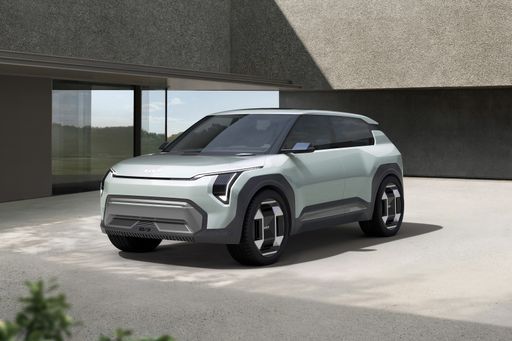 @ Kia Corporation
@ Kia Corporation
Kia EV3
Kia EV3
The Kia EV3 arrives as a cheeky, practical electric compact that manages to feel both premium and playful, delivering crisp handling and a roomy cabin that's perfect for urban life. With smart tech, friendly styling and sensible pricing, the EV3 is the kind of car that makes switching to electric feel like a no-brainer without asking you to give anything important up.
details @ Kia Corporation
@ Kia Corporation
 @ Kia Corporation
@ Kia Corporation
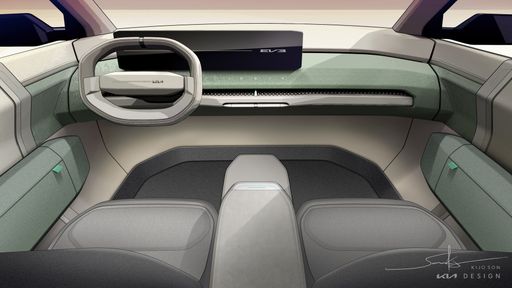 @ Kia Corporation
@ Kia Corporation
Hyundai Inster
The Inster has quickly captured the attention of automotive enthusiasts with its striking design and dynamic performance. This model seamlessly blends advanced technology with comfort, making it an ideal choice for both daily commutes and adventurous road trips. With its spacious interior and innovative features, the Inster promises an exhilarating driving experience that doesn’t compromise on practicality.
details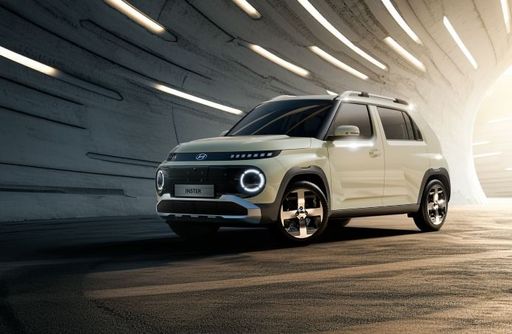 @ Hyundai Motor Company
@ Hyundai Motor Company
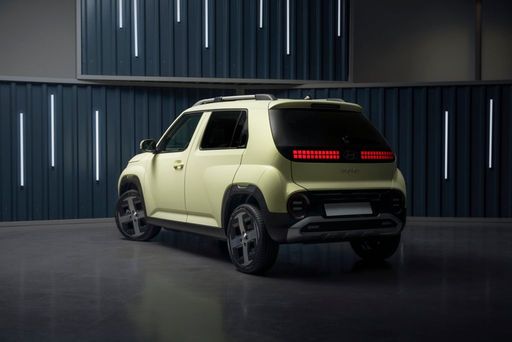 @ Hyundai Motor Company
@ Hyundai Motor Company
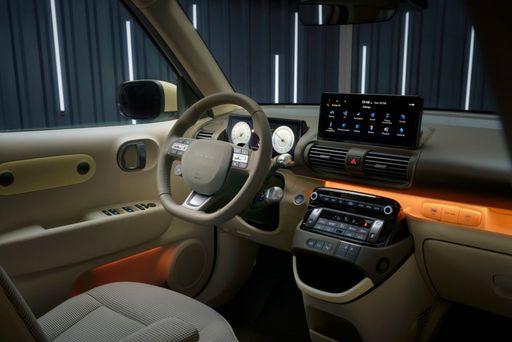 @ Hyundai Motor Company
@ Hyundai Motor Company
 @ Kia Corporation
@ Kia Corporation
|
 @ Hyundai Motor Company
@ Hyundai Motor Company
|
|
|
|
Costs and Consumption |
|
|---|---|
|
Price
30800 - 41700 £
|
Price
20500 - 25800 £
|
|
Consumption L/100km
-
|
Consumption L/100km
-
|
|
Consumption kWh/100km
14.9 - 16.2 kWh
|
Consumption kWh/100km
14.3 - 15.1 kWh
|
|
Electric Range
436 - 605 km
|
Electric Range
327 - 370 km
|
|
Battery Capacity
58.3 - 81.4 kWh
|
Battery Capacity
42 - 49 kWh
|
|
co2
0 g/km
|
co2
0 g/km
|
|
Fuel tank capacity
-
|
Fuel tank capacity
-
|
Dimensions and Body |
|
|---|---|
|
Body Type
SUV
|
Body Type
SUV
|
|
Seats
5
|
Seats
4
|
|
Doors
5
|
Doors
5
|
|
Curb weight
1800 - 1885 kg
|
Curb weight
1380 - 1433 kg
|
|
Trunk capacity
460 L
|
Trunk capacity
238 - 280 L
|
|
Length
4300 - 4310 mm
|
Length
3825 - 3845 mm
|
|
Width
1850 mm
|
Width
1610 mm
|
|
Height
1560 - 1570 mm
|
Height
1575 - 1610 mm
|
|
Max trunk capacity
1251 L
|
Max trunk capacity
1059 L
|
|
Payload
470 kg
|
Payload
317 - 357 kg
|
Engine and Performance |
|
|---|---|
|
Engine Type
Electric
|
Engine Type
Electric
|
|
Transmission
Automatic
|
Transmission
Automatic
|
|
Transmission Detail
Reduction Gearbox
|
Transmission Detail
Reduction Gearbox
|
|
Drive Type
Front-Wheel Drive
|
Drive Type
Front-Wheel Drive
|
|
Power HP
204 HP
|
Power HP
97 - 115 HP
|
|
Acceleration 0-100km/h
7.5 - 7.9 s
|
Acceleration 0-100km/h
10.6 - 11.7 s
|
|
Max Speed
170 km/h
|
Max Speed
140 - 150 km/h
|
|
Torque
283 Nm
|
Torque
147 Nm
|
|
Number of Cylinders
-
|
Number of Cylinders
-
|
|
Power kW
150 kW
|
Power kW
71 - 85 kW
|
|
Engine capacity
-
|
Engine capacity
-
|
General |
|
|---|---|
|
Model Year
2024
|
Model Year
2025
|
|
CO2 Efficiency Class
A
|
CO2 Efficiency Class
A
|
|
Brand
Kia
|
Brand
Hyundai
|
What drive types are available for the Kia EV3?
The Kia EV3 is offered with Front-Wheel Drive.
The prices and data displayed are estimates based on German list prices and may vary by country. This information is not legally binding.
